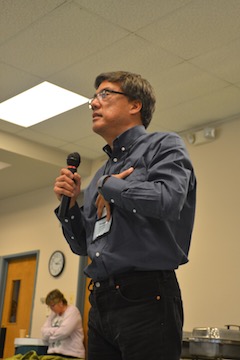At the conference
07/02/15 05:03

The presentations by the leaders of our church’s national ministries used to be a high point of events for me. When I was a new minister it was incredibly stimulating to hear about the programs and projects of our church. These days, however, I don’t have much expectations for national church leaders. The budgets of our church’s national setting have been declining and the people who are attracted to that work no longer seem to be on the “cutting edge” of church growth. Stewards of decline have a different perspective than is helpful for the very alive congregations that I have been called to serve. Additionally, there was a time when the leaders of our church’s national setting had more experience than I and I looked up to them for wisdom and guidance. After 37 years in the ministry, I’ve collected a lot of experience. In most cases I have a lot more experience than our national ministry setting employees. I am often more familiar with church resources and the history of those resources than those we have called to be involved to carry resources to the churches. No surprises there. I’m getting older.
I come to events like this, however, for the keynote speakers and the worship. On that score, Congregations Alive 2 has exceeded expectations. Maren Tiribassi has woven together powerful worship and has engaged our senses with singing, movement, scripture and poetry. Our worship has been rich with elements that I will use in planning worship back in our home church.
In this event yesterday’s keynote presentation by Dr. Rodger Nishioka was worth the entire trip. He drew a challenging time slot for his opening keynote. 24-hours into the conference, he was the speaker after lunch. We had already experienced three workshops and a presentation by a church official. We’d had a really nice lunch and some of us might have been inclined to doze off. There was no dozing, however, during Dr. Nishioka’s stirring three-hour interactive presentation. He kept us spellbound with his exciting first-hand presentations of church growth and development. His understanding of the patterns of decline in the church was complete, but he didn’t dwell with the statistics. He helped us to understand and move on. He also helped us to understand what is working in congregations - how growth occurs and what we can do.
There is no surprise that all of the major studies of churches show that people don’t come to churches because of clever advertising campaigns. While well-done ads do make people who are already in the church feel better about themselves. People who aren’t in the church come because of invitations from others they know and trust. A church grows because its members invite others to participate. And when visitors come, they judge a church and decide whether or not to become involved based on the warmth of their reception. Churches that are warmly welcoming grow. Because people join churches for the sense of belonging, they often are inattentive to the needs of newcomers. They get together because they enjoy being together, not because they want to extend the effort to welcome a newcomer.
That information, however, can easily be gained from reading. What was exciting about yesterday’s presentation was that he engaged us in forming community around the scripture. He had us reading and studying the second chapter of Acts together. We were a large group, mostly sitting eight to a table. In most cases we didn’t know the others at our table well at all, but his guidance and style had us encountering the scripture and looking carefully at how that scripture might inform the life of the contemporary church.
At the same time as I was enjoying the experience and marveling at the gifts of our truly exceptional leader, I was aware that much of what he was leading us to do was replicable in our church. We can have similarly stimulating bible study an discussion in our setting.
Time goes quickly when you are fully engaged. I was amazed at how much we packed into a three-hour session and I was amazed at how quickly it was over.
We have one more keynote from Dr. Nishioka this morning and I am eagerly looking forward to it. It is good to feel the excitement that I used to find and to feel my love for the church and its people overcome the cynicism that I sometimes bring to events of the wider church. I’m quite convinced that God didn’t call me into the church to be a cynic and a critic. When I find myself sinking into that mode and role, I know it is a time for a change of direction. It is one of the ways that I know that I am called to serve the church in a local congregation. I love and am excited about what our church is doing. I feel grateful to be a part of our plans and dreams for the future. I have an entirely different attitude when I attend national church events and activities. I’m not well-suited for ministry in those settings.
Time moves on and soon it will be time to go back home and put to use what we are learning. Today, however, there is a strong sense of anticipation of what lies ahead. There is still much to learn.